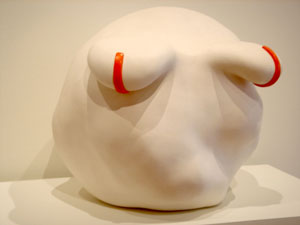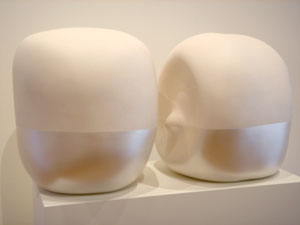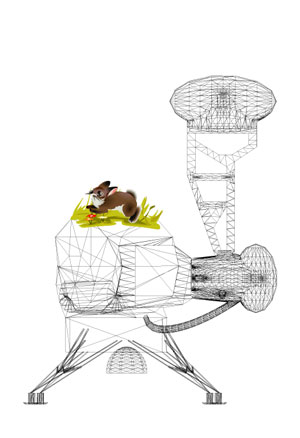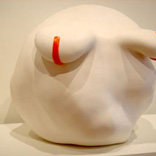Imagine the white rabbit from Pat the Bunny injected into a 21st century adaptation of Alice in Wonderland, or even a DC comic book, and your vision might just come close to Sharon Engelstein’s current show at Mixture Gallery.
Entitled Shapey, this carefully-mapped exhibition features the artist’s most recent drawings and sculptures. In addition to a surprising new series of works on paper, the show presents a variety of uncanny, awkward characters sculpted out of suggestive ceramic forms. For many longtime fans and collectors, the return of these handmade objects, infused as they are with anthropomorphism, evinces the macabre wit that was so compelling in Engelstein’s early biomorphic pieces.
Engelstein continues to be inspired by nonspecific body forms and shapes that fuse the organic with the mechanical. She states about the new body of work, “With a practical use of material and an intuitive approach to formal invention, I return to my earliest methods, but continue to expand on ideas that run throughout the work.” The handmade quality of the sculptures in this show is a departure from the mechanically-formed spherical shapes of her more recent computer-generated sculptures. These new pieces in Shapey are rendered cool, with smooth surfaces that contrast with their various bold shapes, accented with squeaky-clean areas of acrylic-painted stripes, dashes, and dips of luminous colors as perfect as children’s candy. Indeed, enough cannot be said of the quality of Engelstein’s craftsmanship. The smoothly undulating surfaces of the ceramic as well as the impeccable fusion of forms serve to create objects that really look as perfect as something nature itself would have created. But always in Shapey, the formal execution is in service of whatever broader ideas the sculptures suggest.
Viewers can amuse themselves with a host of playful titles. Underpinks is a bulbous figure whose form most closely suggests the intersection of a plush rabbit doll and a weirdly endearing blobbish creature, and which features sculpted bunny ears painted pink on the underside. Then there is One Blue Paw, a rounded form that reminds one of an animated version of a mini Humpty Dumpty figure. In this case, the figure is sitting on top of a shelf with its bottom half painted light blue, with two paws, one of which is painted with the same blue up to the exact same line as the body. And then there is Double Dipped, the painted brown ears of which fondly evoke those Dairy Queen moments of yore.In addition to titles, the groupings of works demonstrate Engelstein’s wit, as viewers attempt to make sense of curious references in the positioning of the sculptures. Poison Girl, a smooth, rounded ceramic piece whose protruded “lips” and body are painted in a lush pink stripe, is loaded with suggestions of the pink, pretty meanness of the nubile young thing. The adjacent Saggy, a figure evoking an organic-looking female torso with implied sagging breasts, is discretely censored with narrow red stripes painted where the “nipples” should be. Both pieces have strong personalities played out with humor and pathos, and involving an amusing commentary on body politics and the sad effects of gravity over time.
Even more comic is the grouping of Biscuit One, Biscuit Two, and Biscuit Three, a set of three small round amorphic blobs, each with two tiny inlets suggesting mini eyes. The figures’ odd shapes and placement on the floor suggest a playful alternate universe where they exist in post-suspended animation. And then there’s Big Innie Outie, a sculpture that combines two bulbous shapes, symbiotic in their relationship to one another. Strategically placed facing one another, one piece offers a slight protrusion while the other one reciprocates with a matching indentation. Big Innie Outie has an interesting antecedent in Brancusi’s sculpture The Kiss inasmuch as the two shapes create a sense of one form.
All these sculptures infuse the abstract with strange humanlike qualities that go beyond conventional notions of the human body (or any other body types for that matter). And they all have a delightfully subtle sense of play. Like the product design of Marcel Wanders, whose objects are inspired by rings of water, suspended goo, and numerous other bulbous shapes, Engelstein’s forms create an intentionally playful, interactive atmosphere in the gallery space.
Equally impressive are Engelstein’s works on paper. These combine the computer-aided grid-like structures in the artist’s prior works with a variety of cartoonish figures, resulting in odd combinations with hints of narrative. In all the drawings is an investigation of space outside the two-dimensional plane. In addition, the tension between the various Bambi-like (almost clipart-ish) creatures and the mechanical drawings of space pods, satellite dishes, and grasshoppers alludes to the process of generating images with computers. Anyone who was watched a “making of” documentary about a Pixar movie is familiar with the sequence: first comes the underling structures (in Engelstein’s drawings, the skeletal grids), then comes the fleshing out (the Bambi cartoons). In the process, the mechanical grids gain a saccharine personality and lose the neutral, if not sinister, aspect of the original featureless skeleton. As computers giveth, so do they taketh away.
Shapey is a masterful demonstration of the artist’s imaginativeness, humor, empathy and craftsmanship. The works tap into primal childhood fairytales, and fuse ideas of play and fantasy with mature notions of identity and artifice by way of abstractive processes and the exploration of a hyperreality. The mythologies embedded in our intuitive core make up the heart of this optimistic, playful, well-executed show.
Images courtesy the artist and Mixture Gallery.
Kristina Spritzer is a writer living in Houston.






